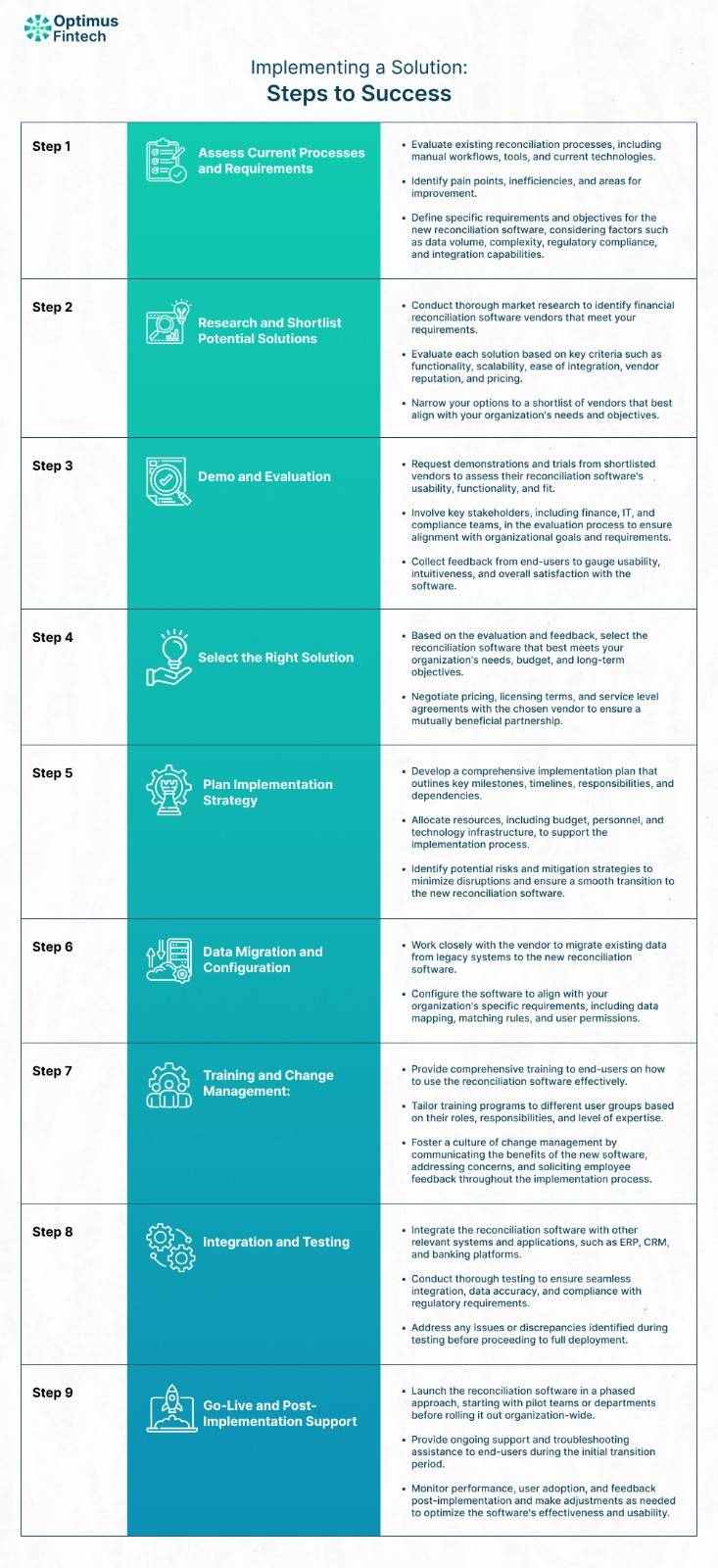Fees & Commission
Streamlining Cash Flow: Cut Payment Reconciliation Delays instantly
Discover how implementing effective payment reconciliation strategies can streamline cash flow and instantly reduce delays, enhancing financial efficiency and control for your business.

Amrit Mohanty
Feb 20, 2024 (Last Updated: Nov 13, 2025)

Is your financial data telling you the full story, or are you lost in translation? It's a question that every business owner, financial manager, or accountant must confront in today's fast-paced economic landscape. Amidst the hustle and bustle of daily operations, critical insights can often become obscured by the complexities of payment reconciliation processes. But what if I told you there's a way to cut through the confusion, streamline your cash flow, and gain unparalleled clarity into your financial health.
In the realm of financial reconciliation, the issue of data quality and management stands as a significant hurdle. A solution that provides clear and confident control over financial data is needed to complete the process. Businesses often need help with disparate data sources, inconsistencies, and delays, leading to inefficiencies in payment reconciliation.
However, there's a solution on the horizon. In our deep dive, we'll explore how the right financial reconciliation software can effectively address this critical problem. We'll delve into the features and functionalities that empower businesses to streamline cash flow by eliminating payment reconciliation delays. From automated matching algorithms to real time data integration, we'll uncover how modern technology can revolutionize financial reconciliation processes, paving the way for enhanced efficiency and accuracy.
The Data Quality Quagmire in Financial Reconciliation
As established earlier, financial reconciliation is critical to business operations, ensuring accuracy and transparency in financial reporting. However, organizations often need help with data quality stemming from disparate financial data sources. This quagmire of data quality issues significantly impacts financial reconciliation processes, leading to inefficiencies and inaccuracies.
Challenges with Disparate Financial Data Sources:
- Fragmented Systems: Many organizations rely on multiple systems and platforms to manage financial data, including accounting software, ERP systems, and banking portals. Each of these systems may use different formats, structures, and coding schemes, making it challenging to reconcile data seamlessly.
- Manual Data Entry Errors: When financial data is transferred between systems manually, errors are inevitable. Whether mistyped figures, incorrect categorizations, or missing entries, manual data entry introduces discrepancies that complicate reconciliation efforts.
- Data Silos: Data silos occur when different departments or divisions within an organization maintain separate databases or systems, leading to fragmented and isolated data sets. Integration is necessary to reconcile financial information across the organization accurately.
- Inconsistent Data Formats: Even within a single system, data may exist in various formats, such as spreadsheets, PDFs, or databases. Inconsistencies in data formats make it challenging to standardize and reconcile information effectively.
Consequences of Poor Data Quality:
- Inaccurate Financial Reporting: Poor data quality undermines the accuracy of financial reports, leading to errors in balance sheets, income statements, and other financial documents. Inaccurate reporting can erode stakeholder trust, damage reputation, and even result in regulatory non-compliance.
- Delayed Decision-Making: When financial data is reliable or complete, decision-makers need more confidence to make timely and informed decisions. Delays in reconciling financial information can hinder strategic planning, budgeting, and resource allocation processes.
- Increased Operational Costs: Resolving data quality issues requires additional time, resources, and manpower. Whether it's conducting manual reconciliations, investigating discrepancies, or correcting errors, poor data quality increases operational costs and reduces efficiency.
- Risk of Fraud and Mismanagement: Inaccurate financial data opens the door to fraudulent activities and mismanagement. With a clear and accurate picture of financial health, organizations may notice discrepancies or fail to detect fraudulent transactions, putting their assets and reputation at risk.
A Unified Approach to Financial Data Management
As already established, efficient financial data management is crucial for maintaining cash flow and driving growth. Yet, many organizations need help with payment reconciliation delays due to disparate data sources and fragmented systems. A unified approach to financial data management is paramount to address this challenge. Businesses can enhance accuracy, efficiency, and decision-making by centralizing financial data and streamlining reconciliation processes. Enter financial reconciliation software—an innovative solution providing a centralized platform for seamlessly managing, reconciling, and analyzing financial data.
Financial reconciliation software offers a comprehensive suite of features tailored to the needs of modern businesses. From automated data integration to customizable reconciliation workflows, these platforms empower organizations to consolidate financial data from disparate sources, including accounting software, ERP systems, and banking portals. By providing a single source of truth for financial information, reconciliation software eliminates data silos, reduces manual errors, and accelerates the reconciliation process.
Realtime updates and alerts ensure stakeholders access accurate and up-to-date financial insights, enabling informed decision-making and proactive risk management. Furthermore, advanced analytics and reporting capabilities offer deeper visibility into financial performance, allowing organizations to identify trends, optimize cash flow, and drive strategic growth initiatives. Financial reconciliation software serves as a robust solution for centralized data management, offering numerous benefits that enhance data quality, accuracy, and accessibility.
Here's how these platforms achieve these objectives:
- Centralized Data Repository: Financial reconciliation software consolidates data from disparate sources into a centralized repository. By bringing together financial information from various systems and sources, businesses can eliminate data silos and ensure consistency across their datasets. This centralized approach improves data quality by reducing redundancy, minimizing errors associated with manual data entry, and providing a unified view of financial information.
- Automated Data Integration: These platforms leverage automated data integration capabilities to seamlessly import data from accounting software, ERP systems, banking portals, and other sources. By automating the process of data extraction, transformation, and loading (ETL), financial reconciliation software minimizes the risk of data discrepancies and ensures that information is up-to-date and accurate. Realtime data integration further enhances accuracy by enabling timely reconciliation and reducing the likelihood of outdated or incomplete data.
- Standardization and Validation: Financial reconciliation software offers tools for standardizing data formats, codes, and classifications across different systems and datasets. By enforcing consistent data standards and validation rules, these platforms help identify and rectify discrepancies, ensuring data accuracy and integrity. Standardized data also facilitates comparison and analysis, enabling stakeholders to make informed decisions based on reliable information.
- Advanced Matching Algorithms: These platforms employ advanced matching algorithms to automatically reconcile transactions and identify discrepancies. Financial reconciliation software streamlines the reconciliation process by comparing transaction records, identifying outliers, flagging potential errors, and reducing the need for manual intervention. This improves efficiency and enhances data accuracy by minimizing human error and oversight.
- Secure Access and Audit Trails: Financial reconciliation software provides secure access controls and audit trails to track changes, monitor user activities, and ensure data integrity. By implementing role-based permissions, encryption, and authentication mechanisms, these platforms safeguard sensitive financial information and maintain compliance with regulatory requirements. Secure access also enhances data accessibility by enabling authorized users to access and analyze financial data from anywhere, at any time, with confidence in its accuracy and reliability.
Choosing the Right Software: Must-Have Features for Data Management
When selecting software for data management, particularly for reconciliation purposes, it's crucial to prioritize features that enhance data quality, streamline processes, and offer unified management capabilities. Here are some must-have features to look for in reconciliation software:
Data Integration Capabilities:
- Seamless integration with various data sources such as databases, spreadsheets, APIs, etc.
- Support for both structured and unstructured data formats.
- Ability to handle large volumes of data efficiently.
Data Matching Algorithms:
- Advanced algorithms for accurate matching of data records.
- Fuzzy matching capabilities to handle discrepancies or variations in data entries.
- Customizable matching rules to accommodate specific business requirements.
Automated Reconciliation Workflows:
- Workflow automation features to streamline reconciliation processes.
- Support for defining and scheduling automated reconciliation tasks.
- Notification/alert mechanisms for identifying and resolving discrepancies in real time.
Data Quality Monitoring and Reporting:
- Tools for monitoring data quality metrics such as completeness, accuracy, consistency, etc.
- Comprehensive reporting capabilities with customizable dashboards and KPIs.
- Exception management features to flag and prioritize data discrepancies for resolution.
Scalability and Performance:
- Scalable architecture to handle growing data volumes and increasing complexity.
- High-performance processing capabilities for rapid reconciliation and data validation.
Data Governance and Compliance:
- Built-in controls for ensuring data privacy, security, and regulatory compliance.
- Audit trails and version control features to track changes and maintain data integrity.
User-Friendly Interface:
- Intuitive user interface with customizable views and navigation options.
- Role-based access control to manage user permissions and access levels effectively.
The Transformative Power of AI and Automation in Modern Reconciliation Tools
When selecting the right software, remember that managing and reconciling vast datasets is paramount for businesses to maintain accuracy, compliance, and operational efficiency. Traditional manual reconciliation processes are time-consuming and error-prone and often need help to cope with the scale and complexity of modern data ecosystems. However, integrating Artificial Intelligence (AI) and automation technologies into reconciliation software has revolutionized these processes, offering unprecedented speed, accuracy, and adaptability.
Enhanced Matching Accuracy:
- AI-powered algorithms can analyze large datasets with unparalleled speed and accuracy, identifying complex patterns and relationships that may elude manual review.
- Machine learning techniques enable reconciliation tools to continuously learn from historical data, refine matching rules, and adapt to evolving data patterns for improved accuracy over time.
- Advanced matching capabilities allow reconciliation software to handle variations, discrepancies, and incomplete data entries more effectively, reducing false positives and negatives.
Streamlined Workflows and Efficiency:
- Automation features enable the streamlining of reconciliation workflows, reducing manual effort and minimizing the risk of human error.
- Robotic Process Automation (RPA) bots can automate routine tasks such as data extraction, validation, and reporting, freeing up resources for more strategic activities and tasks.
- Predictive analytics powered by AI can anticipate potential reconciliation issues and recommend proactive measures, enabling organizations to resolve discrepancies faster and minimize financial risks.
Unstructured Data Handling:
- Natural Language Processing (NLP) technologies enable reconciliation tools to interpret and analyze unstructured data sources such as text-based documents, emails, and PDFs, enhancing the comprehensiveness of reconciliation processes.
- By extracting relevant information from unstructured data sources, AI-powered reconciliation tools can provide a more holistic view of financial transactions, improving decision-making and risk management.
Scalability and Adaptability:
- AI-driven reconciliation software offers scalability to handle growing volumes of data and increasing complexity without sacrificing performance or accuracy.
- Adaptive algorithms can dynamically adjust to changing data environments, ensuring reconciliation processes remain effective and relevant in the face of evolving business requirements and regulatory landscapes.
Implementing a Solution: Steps to Success

Implementation of financial reconciliation software requires careful planning, stakeholder engagement, and strategic execution to ensure successful adoption and integration into existing workflows. This step-by-step guide outlines key considerations and best practices for effectively selecting, implementing, and integrating reconciliation software.
Tips for Training and Integrating Financial Reconciliation Software

Customized Training Programs: Tailor training sessions to different user groups, addressing specific roles, responsibilities, and proficiency levels to maximize understanding and adoption.
Hands-On Workshops: Offer interactive workshops where users can practice using the software in simulated scenarios, promoting confidence and competence.
Continuous Learning Resources: Provide access to online tutorials, user guides, and knowledge bases for ongoing learning and skill enhancement beyond initial training sessions.
User Support Channels: Establish dedicated support channels, such as help desks or online forums, where users can seek assistance, share best practices, and troubleshoot issues in real time.
Feedback Mechanisms: Encourage open communication and feedback loops to gather user insights, address concerns, and refine processes for improved software integration and usability.
Integration Champions: Designate integration champions within each team or department to serve as advocates, mentors, and points of contact for software-related queries and support.
Incremental Rollout Strategy: Implement the software in stages, starting with pilot teams or departments, to identify and address any integration challenges or workflow disruptions before full deployment.
Cross-Functional Collaboration: Foster collaboration between finance, IT, and other relevant departments to ensure alignment of software integration efforts with overall business objectives and requirements.
Documentation and Standardization: Develop standardized procedures and documentation for using the software to promote consistency, efficiency, and compliance across the organization.
Performance Metrics and Monitoring: Establish key performance indicators (KPIs) to track software adoption, usage metrics, and workflow efficiency, enabling continuous improvement and optimization.
Conclusion
Addressing data quality and management issues is fundamental to ensuring financial information's reliability, accuracy, and integrity. Poor data quality can result in erroneous financial reports, misinformed decisions, and reputational damage. Moreover, with data's increasing volume and complexity in today's digital landscape, more than manual reconciliation processes are needed to maintain data consistency and compliance. Organizations must invest in robust software solutions that offer advanced features such as AI-driven algorithms, automated workflows, and comprehensive data governance capabilities to address these challenges effectively.
It is essential for organizations to evaluate their current reconciliation systems and processes critically. They should assess the efficiency, accuracy, and scalability of their existing workflows and identify improvement areas. By considering the transformative potential of the right software solutions, organizations can unlock new efficiency, accuracy, and agility levels in their financial reconciliation processes. Whether automating routine tasks, enhancing data matching algorithms, or improving data governance practices, the right software can empower organizations to overcome challenges, mitigate risks, and drive better business outcomes.

